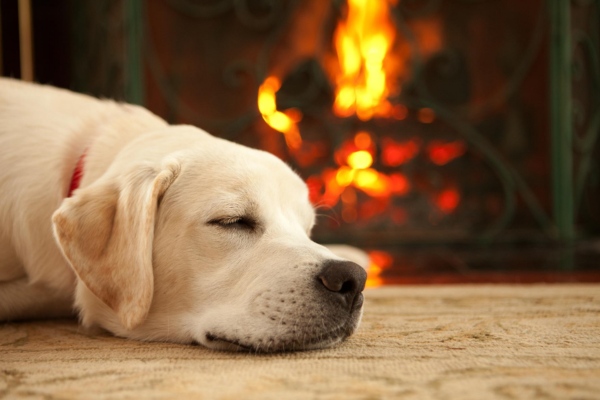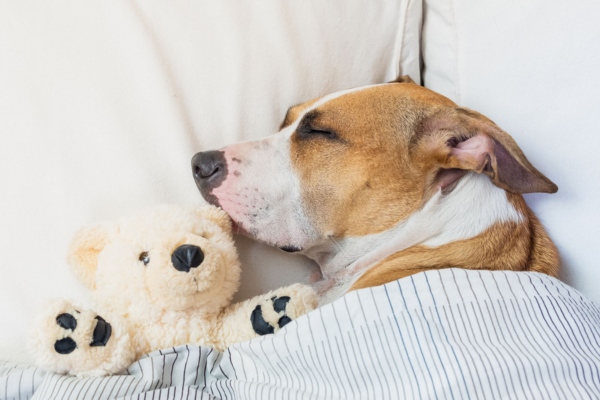Can Dogs Have Nightmares In the realm of sleep and dreams, humans have long been fascinated by the enigmatic nature of nightmares. These nocturnal disturbances can provoke various emotions and leave lasting impressions on our waking lives.
As we continue to explore the intricacies of this phenomenon, it is natural to wonder if other creatures, such as dogs, also experience distressing dreams during their slumber.
This article delves into whether dogs nightmares, drawing upon scientific research and observations from experts in animal behavior.
By examining their sleep patterns, identifying signs of distress during dreaming episodes, understanding the neurological processes underlying dreams in dogs, exploring potential factors that may influence nightmares in canines, and providing guidance on how to support dogs experiencing these troubling dreams, this article aims to shed light on an intriguing aspect of our four-legged companions’ inner lives.
Key Takeaways
- Dogs may experience distressing dreams during sleep, although limited scientific evidence exists on whether they specifically have nightmares during REM sleep.
- Signs of dog nightmares include restlessness, vocalizations, paddling or twitching, and rapid eye movement.
- Dogs exhibit similar brain activity to humans during REM sleep, suggesting they experience vivid dreams and may dream about familiar activities such as chasing or playing.
- Factors that may influence dog nightmares include external stimuli, traumatic experiences, loud noises, unfamiliar environments, and changes in routine. Providing a safe and secure sleeping environment, minimizing exposure to triggers, and maintaining a consistent way can help reduce nightmares in dogs.
The Sleep Patterns of Dogs
The sleep patterns of dogs vary depending on factors such as age, breed, and individual characteristics. Like humans, dogs experience different stages of sleep, including REM (rapid eye movement) sleep.
The dog’s sleep cycle consists of four stages: drowsiness, light sleep, deep sleep, and REM sleep. During the REM stage, dogs may exhibit various behaviors, such as twitching their paws or legs and making small sounds. This is often associated with dreaming in dogs.

Research suggests that during REM sleep in dogs, brain activity is similar to that observed when awake. However, it is essential to note that there is limited scientific evidence regarding whether or not dogs can have nightmares, specifically during their REM sleep stage.
Further studies are needed to fully understand the dreaming patterns and potential occurrence of nightmares in dogs during their sleep cycles.
Signs of Dog Nightmares
One potential indication of unsettling dreams in canines is the display of physical and behavioral distress. Dogs experiencing nightmares may exhibit various signs that can be interpreted as indications of their discomfort during sleep.

These signs include:
- Restlessness: Dogs may toss and turn, frequently changing positions while they sleep.
- Vocalizations: Whimpering, growling, or barking might occur during a nightmare.
- Paddling or twitching: Dogs may move their legs like running or chasing something in their dreams.
- Rapid eye movement (REM): During REM sleep, dogs’ eyes may flutter rapidly under closed eyelids.
Understanding dog body language is crucial when identifying whether a dog is experiencing a nightmare or any other sleep disorder. Pet owners and caregivers can better assess a dog’s well-being and provide appropriate support by paying attention to these signs.
The Science Behind Dog Dreams
Recent scientific research has delved into the fascinating realm of dog dreams, uncovering intriguing insights into the mysterious world of canines’ sleeping experiences. One aspect that researchers have focused on is dog dream interpretation. While it is challenging to fully understand the content and meaning of a dogs dream, studies suggest that their dreams may involve familiar activities, such as chasing or playing.

Dogs often exhibit similar brain activity during Rapid Eye Movement (REM) sleep, associated with dreaming in humans. This similarity suggests that dogs may also experience vivid dreams during this stage of sleep. The role of REM sleep in dog dreams remains unclear, but it is thought to play a crucial role in memory consolidation and learning. Further research is needed to unravel the intricacies of canine dream experiences and their potential benefits for our furry companions.
Emotion Description Example:
- Happiness Feeling joyous or contentment a wagging tail and playful behavior.
- Curiosity Eager to explore or learn Tilting head when encountering something new
- Relaxation Feeling calm or at ease Lying down with eyes closed
Factors That May Influence Dog Nightmares
Factors that may contribute to the occurrence of unsettling dreams in dogs include:
- External stimuli, such as loud noises or unfamiliar environments, can trigger a sense of unease during their slumber.
- Dog anxiety and traumatic experiences, which play a significant role in the manifestation of nightmares.
- Dogs that have undergone distressing events, such as abuse or accidents, are more prone to experiencing nightmares due to the lasting impact these incidents have on their mental well-being.
The following list emphasizes the importance of understanding and addressing these factors to improve a dog’s sleep quality:
- Providing a safe and secure sleeping environment.
- Offering behavioral training and therapy for dogs with anxiety disorders.
- Implementing positive reinforcement techniques to build trust and confidence.
- Seeking professional help from veterinarians or animal behaviorists when necessary.
By considering these factors and taking appropriate measures, owners can help minimize the occurrence of nightmares in dogs and ensure their overall well-being.
How to Help Your Dog with Nightmares
To assist in alleviating distressing dreams in canines, it is essential to implement various strategies that address the underlying causes and promote a sense of comfort during their sleep.
Understanding nightmare triggers can help identify potential sources of anxiety or fear. Common triggers may include loud noises, unfamiliar environments, past traumatic experiences, or changes in routine.
By avoiding or minimizing exposure to these triggers, such as creating a peaceful sleeping environment and maintaining a consistent daily routine, dogs may experience fewer nightmares.
Additionally, calming techniques can be employed to soothe dogs when they wake from a nightmare. These techniques could involve gentle petting, providing a comfortable sleeping area with familiar scents, or playing soft music to induce relaxation.
Creating an atmosphere of safety and security is crucial in helping dogs overcome their nightmares and enjoy restful sleep.
See Also:
- How Many Hours A Day Do Dogs Sleep
- How Do Dogs Dream
- Fun Facts About Dogs: Discovering the Delightful Canine World
- How To Understand Dog Body Language
Conclusion
Dogs can experience nightmares based on the evidence of their sleep patterns and observable signs. The science behind dog dreams suggests that they have similar brain activity during REM sleep as humans do, which is associated with dreaming.
Factors such as stress, anxiety, and past traumas may contribute to nightmares in dogs. Understanding and addressing these factors can help alleviate their distress.
Further research could explore dog nightmares’ specific content and emotional impact to deepen our understanding of canine psychology.
If you can’t find the right dog for you to adopt locally, please consider adopting a dog from Bone Voyage Dog Rescue. We’ll fly with your dog to you.
Frequently Asked Questions
Can dogs have nightmares due to past traumatic experiences?
Dogs can experience nightmares due to past traumatic experiences, similar to humans with post-traumatic stress disorder (PTSD). Understanding and addressing these potential nightmares is crucial in serving the needs of dogs and providing appropriate care.
Are there certain breeds of dogs that are more prone to having nightmares?
Certain dog breeds may be more prone to specific dream patterns. However, further research is needed to determine if particular breeds are more likely to have nightmares or if individual differences within each species influence dream patterns.
Do dogs vocalize or move while they are experiencing a nightmare?
During nightmares, dogs may vocalize and exhibit physical movement. These behaviors could include barking, whimpering, growling, twitching, or even running in place. However, it is essential to note that further research is needed to understand these phenomena fully.
Can dogs have recurrent nightmares about the same thing?
Recurrent nightmares can impact dogs’ behavior. These repetitive and distressing dreams may cause fear, anxiety, and changes in their daily routine. Understanding the nature of these nightmares can help provide appropriate support to alleviate their effects on dogs.
Are there any medications or natural remedies that can help alleviate dog nightmares?
Medications or natural remedies for dog nightmares are limited. Comforting dogs during nightmares involves creating a safe environment, using soothing techniques, and avoiding triggers that can exacerbate their anxiety. Dog nightmare causes vary and require individualized approaches for alleviation.
